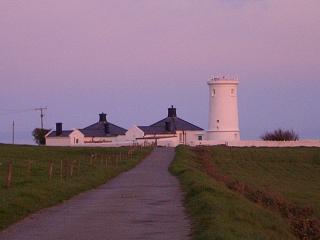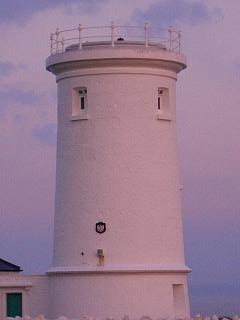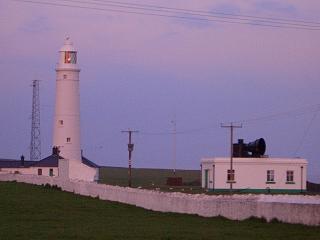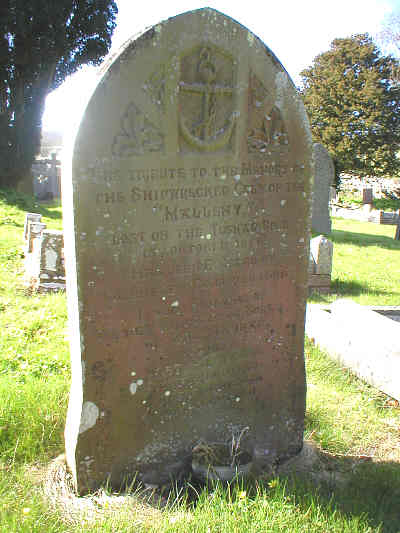Return to main History page
Other History pages: St. Brides
Major | Southerndown |
Ogmore-by-Sea |
Marine | School
The items below are in chronological order so either scroll down or use these quick links to specific items: Ben-y-gloe Frolic Steamer The Gower Pride Lifeguards Flags Malleny Nash Point Lighthouse/s Other Events/Rescues Poem to remember lights safety Port Carreg Smugglers HM Submarine Urge Tides
Nash sand bank off Porthcawl is five miles from our part of the South Wales coast, stretching one mile wide and eight miles long. The sand lies in 20 metre high "waves" and was deposited during the last ice age. It has been estimated that, from 1959, more than 110 million tons of sand was removed in total from the Bristol Channel over the following 50 years, with the greatest amount taken from Nash Bank that has probably reduced by a fifth since the 1920s. The last licence granted by the Crown in circa 2003 allowed 5.4 million tons of sand to be extracted over seven years. Modern dredgers can extract 13,000 tons of sand every two hours and automatically grade it at the same time. Complex local coastal currents carry suspended sand with each tide and have a pattern of removing it from the beaches then depositing it again. Welsh Environment Minister Jane Davidson was reported to have said in early 2009 that dredging of this finite resource would cease in February 2010.
There are many tales of smugglers and ship wreckers who looted stricken vessels and lured sailors to their doom. It is said that sometimes lanterns were attached to sheep on the cliffs to mislead those at sea because when a light was seen bobbing about at night or in bad weather it was taken to be another ship sailing nearer the land. Mariners would then believe that there was a channel of safe water between them. In the 1750s a law was passed that "those who wreck by false light shall be put to death." A huer (meaning shout) was the person who kept a lookout and on seeing land or another vessel would cry out - giving rise to the expression hue and cry.
To watch a video about the wreckers of Dunraven by Wick & Marcross Primary School visit www.youtube.com website
Poem to remember lights safety Back to Top
When both lights you see ahead,
Port your helm and show your red.
Green to green or red to red,
Perfect safety go ahead.
But if to starboard red appear,
It is your duty to keep clear.
To act as judgment says it proper,
To port or starboard back or stop her.
But when upon your port is seen
A steamer’s starboard light of green,
There’s not so much for you to do,
For green to port keeps clear of you.
Both in safety and in doubt,
Always keep a good look out.
When in danger with no room to turn,
Ease her, stop her, go astern.
Frolic, an early wooden, single cylinder steam powered vessel, was bought by 10 enterprising businessmen from Bristol, who ran the General Steam Packet Service. They started a cargo service carrying small packets and goods on a regular run from West Wales to Bristol, also picking up Irish trade coming into Milford Haven. It was one of the first paddle steamers to be operated in the Bristol Channel as a ferry service and was very popular because before the age of the railway it was quicker to travel by sea than road.
Sailing from Haverfordwest during a violent storm on the night of 16th March, 1831 the 34 metre, 108 ton craft (captained by Edwards Jenkins) came to grief on Nash sands at around 3.00 am. The gale force wind was against the tide and this probably overloaded the small 80 hp engine. In all, 78 lives were lost, consisting of 63 passengers, including high ranking officers and a General, many women and children, and 15 crew.
There were no survivors and bodies which were washed ashore from Barry to Southerndown are buried at various churchyards along the coastal area of the Bristol Channel. Army officers Colonel Gordon and General McLeod were on board but as there was no passenger list many who lost their lives were unknown. James Lloyd, late butler of R. L. Ackland of Boulston in the county of Pembroke is buried at St. Bridget's Church.
(Additional information courtesy of Tom Bennett and Phil Carradice on BBC Radio Wales “The Past Master” programme in 2003.)
On Thursday 17th March, 2011, Trinity House made Nash Lighthouse available and a service was held to remember those who had been on board the Frolic paddle steamer and lost their lives 180 years before; the fog horn was also sounded in tribute. A commemorative plaque was unveiled on the Quay at Haverfordwest.
Nash Point Lighthouse/s Back to Top
There was a public outcry at the loss of Frolic and it was this tragedy that led to the Nash Point Lighthouses at Marcross being built by Trinity House in 1832 to warn shipping of the danger. Designed by James Walker, Engineer in Chief, the two towers (which are 302 metres/1,000 feet apart) originally had fixed lights powered by paraffin. When navigating the Bristol Channel the pilot would sail so that these were lined up in his sights, ensuring that the vessel would be south of Nash Sandbank. The Lighthouse Tower near the lighthouse keepers' cottages once housed the west or low light and was 25 metres high. The Lighthouse Tower (originally painted black and white stripes) with the east or high light is 37 metres high and is nearer the fog horn. At the beginning of the 20th century the low light was removed, although the tower remained, and the high light was changed to a catadioptric lens with white and red group flashing. It was electrified in 1968.
Nash Point Lighthouse was the last manned lighthouse in Wales to go automatic when it became computer controlled in 1998 and a rotating optic was installed. The keepers left two years later. The fog horn is no longer used for shipping purposes but is heard when it is sounded on special occasions. Visit Trinity House website for information on lighthouses.



Left photo: Lighthouse Tower and cottages for the lighthouse keepers
Centre photo: Lighthouse Tower which once held the west or low light at Nash Point
Right photo: Lighthouse with the east or high light (originally painted black and white stripes) and fog horn
Portuguese vessel Malleny was an iron ship bound for Rio with a cargo of Welsh coal. It was lost with all hands (20 crew) on or around 14th October, 1886 when she hit Tuskar (Tusker) Rock. Bodies of the seamen were washed up on the shore at Southerndown, Marcross and St. Donats, and gravestones were erected in the churchyards where they were buried, including St. Bridget's. Carpenter Edwin Waters had been paid off at Amsterdam on 8th September, 1886, a fact which was not yet known to his family in Appledore, Devon, so that when he arrived home they were all in mourning and wearing black. The name-plate of the Malleny was washed up at Westward Ho! in Devon* and his grandson bought it for five shillings and took it home. The remains of the ship between the rock and the shore could still be seen until 1979 when they were blown up by the military.
* After the flood disaster at Boscastle, Cornwall, which occurred on Monday, 16th August, 2004, a boat from the area washed ashore at Porthcawl and along the Heritage Coast a number of different items were found such as "Boscastle Tourist," "Fish & Chips" and "Car Park" signs, giving an indication of the strength of the Bristol Channel currents.

Gravestone in
St. Bridget's Churchyard, St. Brides Major,
dedicated to the memory of the Malleny crew
The ship Ben-y-gloe bound for Singapore from Penarth was a full-rigged iron ship which was wrecked when it ran aground at Nash Point near Marcross on 15th October, 1886. People from many miles away went to plunder the wreck and the police searched the area in an attempt to locate the loot. Farm workers hid the ship's ropes underground when they were ploughing, articles were hidden under a chapel pulpit in Wick and a sail was placed in a culvert at Llandow. Irish Farm worker Tommy Burke took the sail to the home of Mrs. Mary Preece in Llandow who took in sewing for 9d a day and she made a jacket from it. A maid cut a piece off the sleeve to make a duster and Tommy promptly had it sewn back on again. Tommy lodged with Mr. & Mrs. Davies (who kept the Post Office) and would walk 15 miles to Cardiff for Mass and then back again, leaving the jacket (which he wore when hedging and ditching) behind the door. There it stayed after his death until the house was being cleared by their son, Jack. A tramp from Monknash was nicknamed Ben-y-gloe because of the amount he had taken from the ship and a cottage was known by the same name because a large amount of tobacco was found buried in the garden. Lord Dunraven sent food to the ship's crew and invited them to visit. They presented Lord Dunraven with the ship's bell and binnacle (the housing for a ship's compass) which were sent to his home in Ireland following the demolition of Dunraven Castle at Southerndown. During the violent storms that occurred at the beginning of 2014, a wreck covering about 60 metres was exposed on the beach at Nash Point which it was thought could be the Ben-y-Gloe.
On 10th November, 1940, the 800 ton steam coaster Port Carreg was sailing from Cornwall along the Bristol Channel when engine trouble left it at the mercy of a storm and it was driven ashore at Craig-yr-Eos Bay. It lay on the sands for several months before being refloated and taken in tow but it broke free off Wick beach and ran onto the rocks. The wreck was bought, cut up for salvage and brought ashore via a steel hawser secured to the keel and a strong metal tripod on the cliff top. The remains can be seen regularly in the winter near Whitmore Stairs and following the extreme storms in 2014 almost the whole of the wreck was exposed.
HMS Urge was ordered from Vickers at
Barrow-in-Furness as part of the 1939 Emergency War Programme. The people of Bridgend and surrounding areas adopted
the submarine and raised £300,000 towards the cost of building it, by holding fund raising events such as whist drives and
dinner dances. While on its way from Malta to Alexandria, the vessel was sunk on 29th April, 1942 with the loss of
all hands, including ten ratings and Bernard Gray who was war correspondent for
the "Sunday Pictorial" and the only unofficial passenger on a British submarine
throughout the Second World War. A plaque was erected in the town
which for some years was hung in Park Street Library but no record of a memorial
service could be found when some research was undertaken, and therefore a
commemorative memorial service was held at 11.00 am
on
On 24th August 2004, the RNLI boat Giles* was launched from Porthcawl lifeboat station and saved the lives of two fishermen, one of whom was injured, from the sea during a gale and a 10 ft / 3 metre swell. The Gower Pride was battling to stay afloat off the local coastline after the treacherously strong currents had caused the vessel to become stuck on Nash sandbank following engine failure. At one point the Gower Pride was thrown against the lifeboat when it was hit by a large breaking wave on the starboard side. During the dramatic rescue in atrocious conditions the tow rope hauling the boat to safety broke and a new tow had to be attached. The fishing boat was then dragged into deeper water and a larger lifeboat that had been called to assist took over whilst the Giles took the injured man ashore to be treated in hospital.
In November 2004 it was announced that Nursery teacher Aileen Jones, volunteer helmswoman, would be honoured for her bravery and awarded the Royal National Lifeboat Institution’s Bronze Medal for Gallantry - the first time since 1888 that a woman crew member had received a decoration. In addition, Crew Member Simon Emms was accorded the Thanks of the Institution on Vellum; Steven Knipe and Mark Burtonwood were presented with Medal Service Badges and Certificates; and Coxswain Martin Double of The Mumbles lifeboat received a letter of appreciation signed by RNLI Chief Executive, Andrew Freemantle.
His Royal Highness the Duke of Kent presented Mrs Jones with her medal on Thursday, 19th May, 2005 at a ceremony held in the Barbican Centre in Central London.
* Porthcawl's Atlantic 75 class lifeboat named after the late Sunday Express cartoonist Carl Giles who raised money for the RNLI by the sale of special Christmas cards featuring his drawings.
Other Events/Rescues Back to Top
Members of the emergency services have saved the lives of many people along our coastline, such as those who have been cut off by the tide, become stuck in mud, fallen from breakwaters or swept into the sea, jet skiers, surfers and swimmers who have underestimated the power of the undercurrents or been caught in the riptide, fishermen overwhelmed by storms, and vessels that have suffered engine failure or a broken mast. Some of the more unusual rescues have occurred when drivers have taken vehicles through the River Ogmore at low tide and become stuck. These circumstances have called for the services of the Fire Brigade, although in many cases the fast flowing water has caused the retrieval attempt to be abandoned until the tide has turned and, usually, taken the vehicle out to sea.
In 2004, the RNLI rescued 7,507 people.
During gale force winds on Wednesday, 27th December, 2007 a fisherman was swept off Witches Point, Dunraven Bay and became the first known person to be successfully rescued after being washed off the notoriously dangerous rocks. The flotation suit he was wearing enabled him to survive 20 minutes in the water whilst awaiting rescue by the Porthcawl lifeboat team who had been summoned by his friend.
Wednesday, 3rd June, 2009 saw the first rescue mission for Porthcawl's Atlantic 85 lifeboat (named Rose of the Shires) when two men drifted out to sea in a rubber dinghy during Force 5 weather conditions and found that they were unable to swim ashore. The Atlantic College RNLI lifeboat also took part in the rescue and retrieved the small 11 ft (3 m) vessel, which had been initially located by a helicopter from RAF Chivenor with the aid of a night vision camera. The men were landed at Ogmore beach.
Two people cut off by the tide at Southerndown were rescued on Sunday, 10th April, 2011 by Porthcawl RNLI Rose of the Shires lifeboat crew, who deployed a small inflatable boat used for shallow-water incidents; the couple had been able to climb onto rocks close to the cliffs and were eventually spotted by kayakers, who then raised the alarm.
On Easter Monday, 25th April, 2011 two children got into difficulty at Ogmore-by-sea as did three adults who went to their aid, because although the sea was calm the current was very strong; all five required medical attention for hypothermia. The RNLI rescued them as well as bringing ashore three surfers who had gone to help.
After two adults and
three children waded across the River Ogmore estuary o
Four teenagers were rescued on the evening of Sunday, 14th August, 2011; they had managed to climb about 30 ft up the cliff face at Southerndown but this meant neither a sea rescue by the RNLI nor a cliff rescue by Llantwit Major Coastguard could be attempted, so RAF Chivenor, Devon, was contacted; a Sea King helicopter winched the group to safety then landed in a field where the coastguard was waiting.
Within five minutes of launch, the Rose of the Shires had reached a motor cruiser in difficulty off Tusker Rock (which is south east of Porthcawl lifeboat station) on Sunday, 21st August, 2011. The vessel's anchor had broken loose, damaged the decking then jammed on the seabed; it was freed by the RNLI towing the motor boat over its anchor chain. The same day, a child's dinghy flipping over the water towards Ogmore was thought to have been blown across from a beach in north Devon by a brisk south westerly wind blowing up the Bristol Channel.
Swansea Coastguard co-ordinated the rescue of four teenagers on Friday, 2nd September, 2011; the girls had been caught out by the speed of the incoming tide and were asked to stay on their mobile phones to help the Porthcawl lifeboat locate their exact position in the darkness. Two of the crew from the Rose of the Shires then used a smaller boat to take them off the cliff base at Southerndown and to the lifeboat.
Attempting to walk from Ogmore-by-Sea to Southerndown on Tuesday, 25th October, 2011 led to a man being cut off by the tide and trapped on a ledge, then being airlifted to safety in a rescue operation overseen by the Maritime Co-ordination Centre in Swansea that involved Porthcawl Coastguards, RNLI Porthcawl, RAF Rescue 169 and South Wales Police.
Poor visibility owing to fog caused two fishermen to become lost near Monknash beach on Saturday, 10th March, 2012. They were found under the cliffs near Whitmore Stairs (approximately one mile east of Southerndown beach) at around 5.20 am with one of the highest tides of the year due at 7.32 am. Porthcawl lifeboat radioed the Coastguard and made contact with the men via mobile phone to ask them to flash their torch, then anchored and kept watch whilst awaiting the Coastguard team from Llantwit Major, who subsequently led the pair to safety. The Atlantic College RNLI lifeboat also attended and illuminated the area.
Members of Llantwit Major Coastguard Search and Rescue team, Welsh Air Ambulance and the RAF Sea King from Chivenor, were involved in two separate rescues on Sunday, 18th March, 2012. A man was climbing a rocky outcrop near the base of the steps leading to Traeth Mawr, Southerndown, when he fell and broke his leg. The other man fell approximately 80 metres down from the footpath near West Farm, Ogmore, and was less than a metre from the edge of the cliff.
A woman who slipped on wet rocks and fell about three metres at Southerndown on Sunday, 22nd July, 2012 was airlifted to safer ground by the Air Ambulance, assisted by Llantwit Major Coastguard, then taken by land ambulance to hospital.
RNLI lifeguards went to the aid of a woman who had injured her arm after falling from the pebble bank at Southerndown on Sunday, 19th August, 2012. Emergency services were called and transported the casualty to hospital.
Students walking the coastal path on
Saturday 9th February, 2013 left the route but were unable to find it again from
the beach and on noting the rising tide rang for assistance.
Following a call from someone in Ogmore-by-Sea, Porthcawl
RNLI went to the aid of a 30-foot steel-hulled sailing yacht that had taken on
water, was drifting towards the rocks and was in danger of sinking at Newton
Seven-month-old labradoodle Ben proved very boisterous
In 2012, the RNLI increased patrols to include safety cover for Ogmore-by-Sea and Southerndown beaches for approximately eight weeks from the end of July to the beginning of September and that year went to the aid of 36 people on Southerndown Beach and 38 people (35 incidents) on Ogmore-by-Sea Beach.
In 2013, RNLI Lifeguards responded to 329 incidents, rescued 30 people and saved six lives on Vale of Glamorgan beaches.
Volunteers from local surf life-saving clubs patrol the beaches in the summer and at peak times, staying later on particularly busy days.
If flags are flying: Bathe between red and yellow flags as these indicate a patrolled area and therefore the safest place and boundary for swimming or body-boarding; black and white flags fly for surfing, kayaks and other non-powered craft; an orange windsock shows offshore winds or unsafe water conditions. red flags mean do not enter the water.
Following a tragedy at Ogmore-by-sea in 1991 a safety film was produced (shot at Porthcawl and Ogmore-by-sea) which was put on the Internet in 2012; visit www.youtube.com website to view this.
Spring tides in March and September are some of the biggest of the year. Tide tables can be obtained from local fishing tackle shops, marine and chandler's stores, tourist information offices, local publications, and online via surfing sites such as those on our Clubs page; also see our General Information page for links. Some tables give high tide only whilst others show low tide as well; you may have to adjust the times shown for BST. Tide times are usually displayed at Dunraven Bay and Ogmore-by-Sea. Remember that the times of the tide vary slightly as you travel along the coastline.
Visit Porthcawl Lifeboat website or the RNLI website
Visit Maritme and Coastguard Agency website
And don't forget to look at the Weather gallery!!!
Other History pages: St.
Brides Major | Southerndown |
Ogmore-by-Sea |
Marine | School
Return to main History page